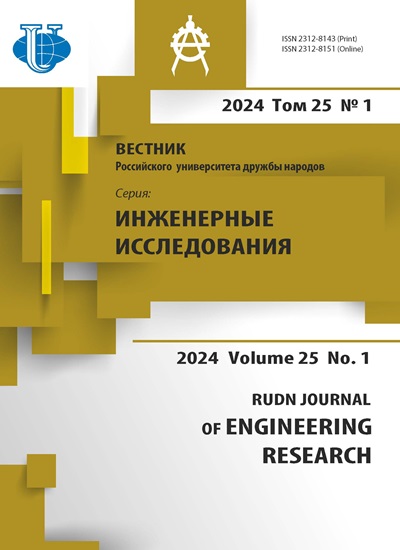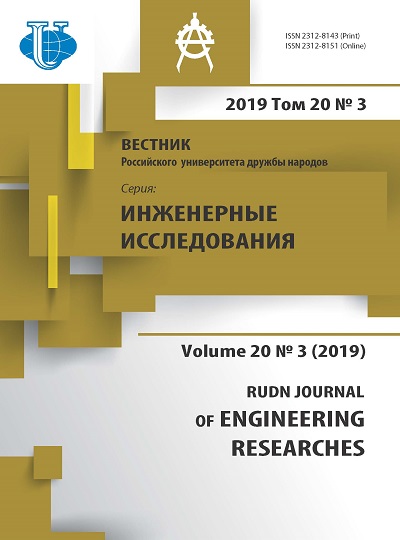Vol 20, No 3 (2019)
- Year: 2019
- Articles: 6
- URL: https://journals.rudn.ru/engineering-researches/issue/view/1311
- DOI: https://doi.org/10.22363/2312-8143-2019-20-3
Full Issue
Aviation and rocket and space technology
Simulation of cooling of a processor in nanosatellite using the loop heat pipes
Abstract
One of the key problems in the development of nanosatellites is to provide a given temperature range for the operation of electronic equipment, the heat transfer of which can be tens of watts. Thermoregulation systems traditional for large spacecraft are not suitable for nanosatellites due to limitations on their mass and size characteristics. The indicated thermal regime of nanosatellites can be achieved using remote heat removal systems - miniature loop heat pipes. In recent years, their mass production has been established in Russia, but they have not yet found wide application in nanosatellites. The aim of the paper is to substantiate the possibility of using miniature loop heat pipes to remove excess heat from the on-board computer processor to the carbon-plastic case of the nanosatellite. Parametric modeling of the influence of geometric dimensions and the values of the effective thermal conductivity coefficient of loop heat pipes on the processor temperature was carried out in the ANSYS program. Calculations showed that the use of contour heat pipes will reduce the processor temperature to acceptable values. The anisotropy of the thermal conductivity coefficient in the reinforcement plane of the composite material of the nanosatellite case can have a significant effect on the temperature of the processor. This opens up prospects for the use of anisotropic composite materials to ensure the thermal regime of the nanosatellite.
 211-219
211-219


Energy cost analysis to station keeping for satellite formation type “TerraSAR-X - TanDEM-X”
Abstract
The maintenance of a given configuration of the satellite formation of the “TerraSAR-X - TanDEM-X” type is considered. It is assumed that the master satellite performs only maneuvers to maintain the working orbit, and the slave satellite performs identical maneuvers to maintain the working orbit and additionally performs maneuvers to maintain a given relative configuration of the group. For the working orbit of the master satellite, the dependence of the total characteristic velocity costs for maintaining a large semi-axis, eccentricity, inclination, and their various combinations on the maintenance accuracy is studied. The minimum limits of accuracy at which maneuvering is not required are set for each of the elements. This study is general in nature and allows future missions to be planned, providing the necessary trade-offs between the accuracy of maintenance and the total characteristic speed costs that increase as maintenance accuracy increases. Also, a study of the energy costs of relative maintenance, provided that the engines of the master and slave satellites operate almost the same. It is shown that the relative maintenance requires significantly lower fuel costs, even with the accuracy required in the project. The software product developed for this study is of universal application and will be used to investigate the cost of maintaining a more complex system of four satellites, in which three satellites rotate relative to the base satellite.
 220-228
220-228


Earth science
The influences of the crude oils on the decay of metals
Abstract
Crude oils are the essential resources for the usages of industrial purposes in various forms and the refining is a key process of separating the mixture of raw crude oils. In the existing research there were expected to investigate the impact of salts, organic acids, mercaptans and elemental sulfur of crude oils on the corrosion rates of seven different types of ferrous metals in both qualitatively and quantitatively. The chemical compositions of such selected ferrous metals and the above mentioned corrosive properties of two different types of crude oils were measured by the standard instruments and methodologies. A set of similar sized metal coupons were prepared from seven different types of metals and the corrosion rates of such metals were determined by the relative weight loss method. In addition, that the corroded metal surfaces were analyzed under the microscope, decayed metal concentrations and deductions of the initial hardness of metal coupons were measured. According to the obtained results that there were observed the lower corrosion rates from stainless steels with at least 12% of chromium and nickel, higher corrosive impact from salt, formations of FeS, Fe2O3, corrosion cracks and pitting corrosion.
 244-253
244-253


Increasing efficiency of work of a liquid-gas ejector
Abstract
The proposed solution relates to fluidics and can be used, for example, in the extraction of oil and gas, the collection and preparation of oil, gas and water, the extraction of methane from methane beds, oil refining. The technical result is to increase the efficiency of a liquid-gas ejector by ensuring its work in the field of rational concentrations and salt composition, in which the intensification of energy exchange between the working fluid and the ejected gas is achieved. The essence of the proposed solution: the method of operation of a liquid-gas ejector involves injecting a working fluid with a power pump into the ejector nozzle, pumping gas with an ejector, creating, dispersing and increasing the pressure of a gas-liquid mixture with an ejector using aqueous solutions of salts as a working fluid. The values of the concentration and composition of salts in the working fluid are maintained within the range of rational concentrations and composition of salts, in which increased values of the efficiency of the ejector are achieved. Salts are added to the weakly mineralized aqueous solutions, and the highly mineralized aqueous solutions are diluted with fresh water. As the working fluid, the formation and/or incidentally produced waters of oil, gas, gas condensate and methane-coal deposits, which are aqueous solutions of salts, are used if the composition and concentration of salts in the produced and/or incidentally produced waters are within the range of rational concentrations and composition of salts in which provides an increase in the efficiency of the ejector. The boundaries of the field of rational concentrations and salt composition are preliminarily determined by laboratory bench studies.
 254-260
254-260


Mechanical engineering and machine science
Pier scouring reduction using a Strip Guide Flow Panel device
Abstract
A set of laboratory experiments were conducted to study the effect of using a Strip Guide Flow Panel device to reduce scour process effects around a bridge pier. Three cylindrical piers of different diameter values and three different Strip Guide Flow Panel devices were used. Every Strip Guide Flow Panel device is simulated by two arms connected together at one of their edges at a right angle. The length of every arm is selected in a way to cover the pier diameter. Every Strip Guide Flow Panel was mounted on the upstream face of the corresponding cylindrical pier diameter at elevation adjacent to the flume bed. A uniform sized sediment were used as a bed material. Based on the experimental data, an acceptable range of scour reduction efficiency (35.71-66.67%) and high hydraulic safety factors were obtained when using Strip Guide Flow Panel. Also it is found that the scour depth when using Strip Guide Flow Panel is small comparing with corresponding potential and maximum scour depth values. So it can be concluded that the Strip Guide Flow Panel device can work like a turbulence kinetic energy dissipater to reduce the risk of scour around the pier during the serviceability life of bridge structure.
 229-235
229-235


Application of intelligent systems in transport
Abstract
The article discusses the application of intelligent transport systems for railway transport. The purpose of developing intelligent transport systems on railway transport is to strictly comply with the requirements for ensuring transport safety, reducing the level of environmental impact, significantly improving the efficiency of production activities. The software makes automatic accounting, control and analysis of fuel and energy resources consumption on the basis of the obtained data. At the same time, the dynamics of changes in fuel consumption indicators, actual and estimated costs of diesel fuel are visually reflected in real time on the monitor screen. If necessary, the system will help to identify the reasons for non-matching of these parameters and quickly contact the locomotive team to provide qualified assistance in their elimination. It is important that the hardware structure and the structure of the system software expand functionality, providing continuous operation and repair work, increasing the number of measured parameters, creating a closed fuel consumption control system in a locomotive economy. The use of these systems makes it possible to obtain an integrated assessment of the heat engineering condition of a locomotive with further scientifically substantiated correction of overhaul runs, to control its location and solve many other problems, which contributes to an increase in overhaul runs and the operational life of the locomotive.
 236-243
236-243
















